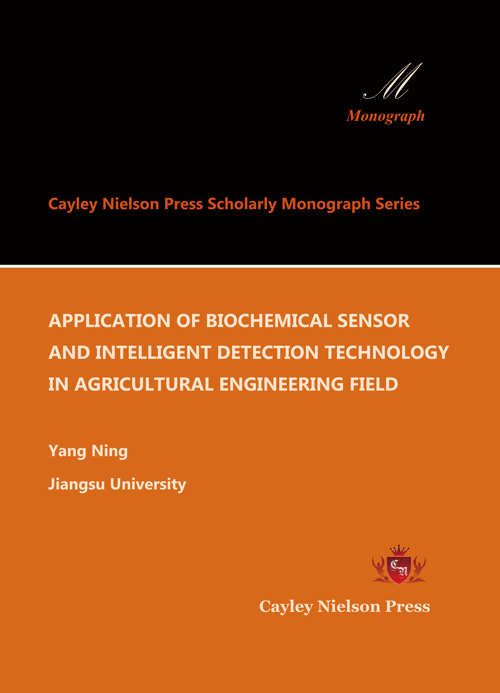
APPLICATION OF BIOCHEMICAL SENSOR AND INTELLIGENT DETECTION TECHNOLOGY IN AGRICULTURAL ENGINEERING FIELD

Yang Ning
Jiangsu University
Copyright © 2020 by Cayley Nielson Press, Inc.
ISBN: 978-1-734882-4-7
Cayley Nielson Press Scholarly Monograph Series Book Code No.: 210-12-8
US$180.50
Contents
Chapter 1 Pesticide and veterinary drug residue detection technology based on paper chip 1
1.1 Pesticide residue detection technology based on paper chip 1
1.1.1 Pesticide residue detection method based on paper chip 3
1.1.2 Application of pesticide residue detection based on paper chip 13
1.2 Veterinary drug residue detection technology based on paper chips 23
1.2.1 Veterinary drug residue detection method based on paper chip 23
1.2.2 Application of veterinary drug residue detection based on paper chip 28
1.2.3 The summary 32
Chapter 2 Detection technology of crop disease spores based on gas microfluidic technology 34
2.1 Detection technology of mold spores based on gas microfluidic technology 34
2.1.1 Introduction of detection of airborne disease microorganisms based on microfluidic chip 34
2.1.2 Detection of spore mechanism of crop disease by gas microfluidic technology 35
2.1.3 Structure design of microfluidic chip with spore enrichment for crop disease 40
2.1.4 Simulation 42
2.1.5 Experimental results and analysis 44
2.2 Detection technology of the blast fungus spores based on gas microfluidic technology 48
2.2.1 Characteristics of the blast fungus spore 48
2.2.2 Detection of spore mechanism of crop disease by gas microfluidic technology 48
2.2.3 Structure design of microfluidic chip with spore enrichment for crop disease 50
2.2.4 Simulation 52
2.2.5 Experimental results and analysis 58
Chapter 3 Microbiological detection technology based on microfluidic photoelectric sensor 59
3.1 Microbial detection technology based on microfluidic light scattering 59
3.1.1 Principle of light scattering detection 59
3.1.2 a novel measurement of immune agglutination particle size using micro image identification 62
3.1.3 Result comparison and analysis 69
3.2 Microfluidic low noise optical density detection technology for microorganisms 70
3.2.1 Optical density Detection principles 70
3.2.2 To find a method to reduce the impact of metal ions suspended solids on the absorbance 71
3.2.3 Detecting the bacterial concentration by establishing piecewise curve regression under two absorbencies 74
3.3 Microfluidic diffraction optics was used to detect microorganisms 84
3.3.1 The lensfree diffraction fingerprint Detection principle 84
3.3.2 A crop diseases spore detection method, based on the lensfree diffraction fingerprint and microfluidic chip 85
3.3.3 The detection results of rice blast spores were obtained 89
3.4 Optical path offset compensation method for microfluidic chips 95
3.4.1 Principle of photometric detection 95
3.4.2 Detection methods Compensation method of error caused from maladjustment of optical path based on microfluidic chip 96
3.4.3 Result and Discussion 98
3.5 Summary 100
Chapter 4 Crop and microbial detection technology based on infrared thermal imaging 102
4.1 Tea detection technology based on infrared thermal imaging 102
4.1.1 Principle of infrared thermal imaging 103
4.1.2 Image acquisition and processing 105
4.1.3 Verification of the feasibility of infrared thermal imaging processing technology 116
4.2 Microbe (cell) detection technology based on infrared thermal imaging 122
4.2.1 Evaluation of cellular activity 123
4.2.2 Cell activity detection method based on micro-infrared thermal imaging sensor 125
4.2.3 Test results and analysis 133
4.3 Summary 145
Chapter 5 Microbiological detection technology based on visible light imaging 147
5.1 Cell detection technology based on visible light imaging 147
5.1.1 Principle of Cell Diffraction Detection 148
5.1.2 Microscopic image detection principle of cells 148
5.1.3 Test results and analysis 152
5.2 Spore detection technology based on visible light imaging 157
5.2.1 Principles of microscopic identification of spores 157
5.2.2 Spore microscopic feature recognition method 159
5.2.3 Test results and analysis 169
5.3 Summary 177
Chapter 6 Microbial detection technology based on impedance spectroscopy 179
6.1 Cell detection technology based on impedance spectroscopy 179
6.1.1 Detection principle of cell detection technology based on impedance spectroscopy 179
6.1.2 Method of cell detection by impedance spectroscopy 180
6.1.3 Results and analysis of cell detection with impedance spectroscopy 186
6.2 Rice blast spore’s detection technology based on impedance spectroscopy 197
6.2.1 The principle of impedance spectroscopy to detect the rice blast fungus 197
6.2.2 Method and process for detecting rice blast fungus based on impedance spectroscopy 199
6.2.3 The result and analysis of detecting Magnaporthe grisea by impedance spectroscopy 204
Chapter 7 Microbiological detection technology based on micro-spectrum 211
7.1 Bacteria fast decoupling detection based on Raman spectra and fluorescence microscopy 211
7.1.1 The detection principle of bacteria fast decoupling 211
7.1.2 The detection method and device of bacteria fast decoupling 212
7.1.3 Experiment and analysis 219
References 225
Readership
This book should be useful for students, scientists, engineers and professionals working in the areas of optoelectronic packaging, photonic devices, semiconductor technology, materials science, polymer science, electrical and electronics engineering. This book could be used for one semester course on adhesives for photonics packaging designed for both undergraduate and graduate engineering students.
